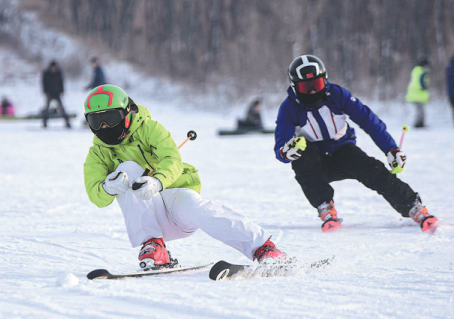

In September 2018, the General Administration of Sport released an outline, which aimed to engage 300 million Chinese in winter sports by 2022 and thus better prepare for the Olympics. Winter-related industries are expected to reach 1 trillion yuan in value by 2025, according to the administration's development plan.
The country is anticipating a boom in ice-and-snow tourism ahead of the 2022 Winter Olympics, says a China Tourism Academy report issued early this year. China received 224 million tourists from home and abroad during the winter season from late 2018 to early 2019, a 13.7 percent increase compared with the previous period.
Winter-tourism revenue reached 386 billion yuan during the same period, a 17 percent year-on-year increase, according to the report.
Major winter destinations have rolled out special packages to woo travelers.
Beijing, Tianjin and Hebei kicked off a joint winter-tourism promotion in mid-December. The event aimed to integrate winter-tourism resources and boost winter sports and culture to pave the way for the country's hosting of the 2022 Games.
The three destinations focused on innovation and rolled out winter experiences that feature culture, tourism, sports and technology across the Beijing-Tianjin-Hebei region.
Northeastern Beijing's Miyun district has developed skiing, sightseeing, health-preservation, homestay, gourmet-food and shopping experiences for winter vacationers.
"We will combine winter resources, rural tourism and sports events this year," says Miyun's publicity department head Ge Junkai.
Pinggu district in the capital's northeast has prepared organic-vegetable picking, flower-blossom sightseeing with a focus on chrysanthemums and fairs to enable visitors to experience local life in addition to winter sports.
Tianjin has prepared winter carnivals and ski competitions, while Hebei's Chengde city has developed 18 winter routes, integrating royal-family history, hot springs, folk customs and shopping.
China's northernmost province, Heilongjiang, has publicized 15 winter-tourism destinations and launched a series of events featuring art, sightseeing, hiking, fishing, hot springs, folk customs, culture and performances.
More than 400 cultural and recreational activities are planned in the provincial capital, Harbin, and the city's government will distribute 48 million yuan in subsidies on online platforms. Some hot spots, such as the Harbin Ice and Snow World, will offer discounted tickets.
Yabuli ski resort is allowing travelers to use three of its major runs with a single pass.
Travelers in Heilongjiang's Mohe can also enjoy forest-train rides and night skiing in Xuexiang village, as well as water-splashing performances, international cross-country auto races, hot springs and hotpot.
Neighboring Jilin province has rolled out new tourism products and favorable policies. Since mid-November, a 100-day winter tourism festival has been running in the provincial capital, Changchun, where visitors can experience 100 winter activities, including marathons, large ice sculptures and a gourmet-food exhibition.